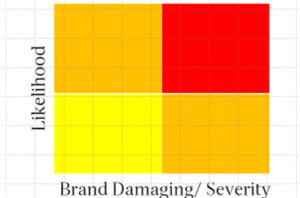What if you woke up tomorrow morning to a story in The Guardian about 124,000 leaked documents from your company? Those documents detail your executive team’s aggressive, often callous, and sometimes illegal acts. How would you respond? Perhaps the Uber communications team was not prepared for precisely the situation that unfolded this week. Still, they were absolutely ready for a scenario of investigative reporting that laid bare the business practices of its former CEO. Evaluate their prepared statement:
- “It’s… exactly why Uber hired a new CEO, Dara Khosrowshahi, who was tasked with transforming every aspect of how Uber operates. … We’ve moved from an era of confrontation to one of collaboration.”
- “We have not and will not make excuses for past behavior that is clearly not in line with our present values,” the statement concludes. “Instead, we ask the public to judge us by what we’ve done over the last five years and what we will do in the years to come.”
This Uber team knew, at some point, the company would come under more scrutiny for its past management practices. Lucky for the communications team, they were operating under the direction of a new CEO, and they’d prepared themselves for this very type of bad publicity. They moved quickly to acknowledge but distance the company from its previous CEO. “Yes, that was bad – but we’ve changed,” was the clear message.
You might be thinking, “That’s not us. That would never happen.” And you’re probably right. But you will face other business crises, and it’s important not to be surprised by them. How many of these scenarios can you imagine your business facing?
- A senior executive is accused of sexual harassment
- You need to lay off 20% of your staff
- A competitor files an IP infringement lawsuit
- You experience a service outage for a prolonged period
- Customer complaints gain steam on social media
- The ERP system is taken down by ransomware
- Shareholder activist demands sale of company
These are not outrageous, unimaginable scenarios. In my career, I’ve encountered most of them already. And based on experience, I can tell you that when faced with a crisis, a company’s biggest enemy is TIME. If your team is trying to figure out who to call, what process to follow, and develop a response to a crisis on the fly, your decision-making is poor, and you are at least two steps behind where you need to be. This is a nightmare scenario and why businesses need crisis communications plans.
Formulating a Crisis Communication Plan
Unfortunately, most companies don’t prioritize crisis communications planning until they’ve learned the hard way. Sometimes, a competent and experienced Board of Directors will dictate this type of risk management activity. If this is where you are, your next step should be to identify a handful of issues that keep your executive team up at night and build plans for those issues.
If you want to be more collaborative and precise about which plans to develop, assemble a core group of functional leaders to do some soul searching. At a minimum, you should include heads of communications, legal, HR, IT, operations and products or services. Give this group a framework for considering the types of crises you may face as an organization. Explain that most crises fall into six categories of issues:
- Physical (fire, security breach, accident)
- Financial (SEC audit, stock drop, missed earnings)
- Natural Disaster (hurricane, flood, pandemic)
- Human Resources (labor strike, harassment, lay-offs)
- Reputation (product issues, ethics, rumors)
- Psychopathic (terrorism, workplace violence)
Ask this team to consider the scenarios they can imagine taking place within the business. Then, on a scale of 1-10, rate those scenarios based on two factors: their likelihood of happening and how brand-damaging the scenario would be. Plot these scenarios on a four square. The top right box is your first priority.

This is a great starting place for developing a holistic view of the organization and any brand risks it may face. Business consultants that practice this technique would stress the importance of not overwhelming your team by committing to developing ten crisis plans all at once. Instead, start with two to three top priorities and build from there.
What should be in your plan? At a minimum, your plan should provide you the opportunity to consider the issue in its entirety:
- how it might arise
- who your stakeholders are and what they care about
- what messages you’d want to convey
- how you’d answer tough questions
- who’s on point, internally, for decision making and communications
There is no such thing as a perfect plan, and you will not be able to imagine all the curve balls that may arise. But, a solid crisis plan will give you the head start you need to respond quickly and effectively—two critical elements of crisis communication and brand protection.